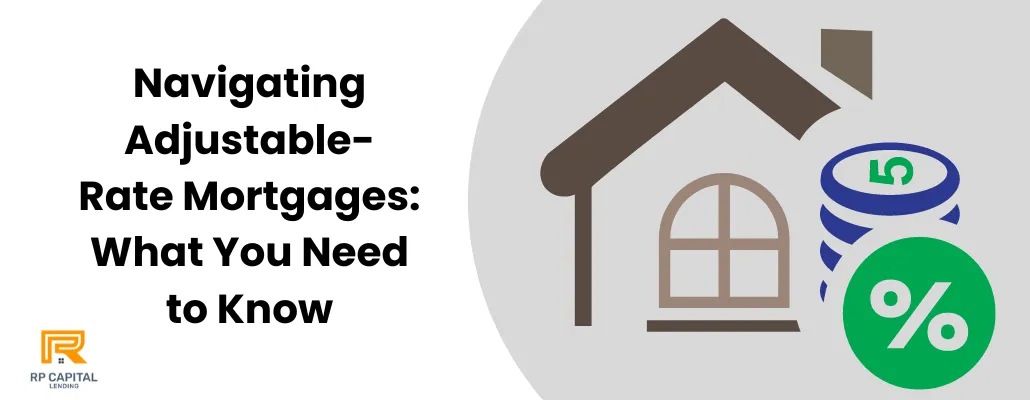Blog

Navigating Adjustable-Rate Mortgages: What You Need to Know
Adjustable-rate mortgages (ARMs) present a unique financial tool for prospective homeowners, blending initial affordability with potential long-term variability. These mortgages start with attractive lower interest rates that adjust over time based on market conditions.
While they offer benefits like reduced initial payments and potential cost savings, they also carry risks including rising payments and complex terms.
Understanding the pros and cons of ARMs is crucial for anyone considering this type of mortgage to align it with their housing needs and financial plans.
What is Adjustable-Rate Mortgages?
Adjustable-rate mortgages (ARMs) are a type of home loan with interest rates that adjust over time based on the performance of a specific benchmark or index. Unlike fixed-rate mortgages that keep the same interest rate for the duration of the loan, ARMs change, which can affect monthly payments and overall cost. Understanding the details of ARMs can help you decide if this type of mortgage aligns with your financial goals.
Key Features of Adjustable-Rate Mortgages:
Initial Fixed-Rate Period: ARMs typically start with a fixed interest rate for a set period (usually 5, 7, or 10 years), after which the rate adjusts periodically.
Adjustment Period: After the initial fixed term, the interest rate adjusts at regular intervals. This could be annually, semi-annually, or monthly, depending on the specific terms of the mortgage.
Index Rate: The adjustment is based on an index rate, such as the London Interbank Offered Rate (LIBOR) or the Secured Overnight Financing Rate (SOFR).
Margins: Lenders add a certain number of percentage points called the "margin" to the index rate to determine the new interest rate.
Rate Caps: These limit how much the interest rate can increase during each adjustment period and over the life of the loan, protecting borrowers from drastic rate increases.
Pros of Adjustable-Rate Mortgages (ARMs)
Lower Initial Payments: ARMs often offer lower initial interest rates compared to fixed-rate mortgages, making them more affordable in the short term and appealing to buyers who might need lower payments early on.
Potential for Decreasing Rates: If the index rate that the ARM is tied to decreases, the interest rates on the mortgage could also go down, potentially lowering monthly payments.
Initial Fixed-Rate Period: ARMs typically start with a fixed-rate period where the interest rate doesn't change, providing stability for budget planning during these initial years.
Flexibility for Short-Term Plans: An ARM can be a smart financial choice for individuals who plan to sell or refinance their home before the end of the fixed-rate period, thus avoiding the risk of rate adjustments.
Cap Limits: Rate caps limit how much the interest rate can increase during adjustment periods and over the lifetime of the loan, protecting borrowers from extreme increases in interest rates.
Potential for Overall Cost Savings: If interest rates remain stable or decline over the term of the loan, borrowers may end up paying less in total interest compared to a fixed-rate mortgage.
Cons of Adjustable-Rate Mortgages (ARMs)
Rate Increase Risk: After the initial fixed period, interest rates can increase depending on market conditions, potentially leading to significantly higher monthly payments.
Complexity: ARMs are more complex than fixed-rate mortgages, with terms and conditions that can be difficult for some borrowers to understand fully, such as indexes, margins, adjustments, and caps.
Uncertainty in Long-Term Planning: Due to the potential for fluctuating payments in the future, it can be challenging to plan long-term finances with certainty when you have an ARM.
Potential for Negative Amortization: In some ARMs, if the interest rate increases sharply and payment caps keep the payment amount too low, the unpaid interest may be added to the principal amount, increasing the total debt owed.
Refinancing Risks: If borrowers decide to refinance to a fixed-rate mortgage or another ARM, there might be costs involved, and they may end up with higher rates if market conditions are unfavorable.
Less Favorable for Long-Term Ownership: For those planning to stay in their homes for a long time, the uncertainty and potential for higher payments in the future make ARMs less attractive compared to fixed-rate mortgages, which offer predictable payments.
FAQs on Adjustable-Rate Mortgages:
1. What happens when the interest rate adjusts for the first time on an ARM?
The new rate is calculated by adding the margin to the current index rate, subject to any agreed rate caps.
2. How often do ARM rates adjust?
This depends on the terms of your mortgage. Common adjustment periods are annually, but they can be more frequent.
3. What are rate caps in ARMs, and why are they important?
Rate caps limit the amount the interest rate can increase, protecting you from sudden and potentially unaffordable increases in your monthly mortgage payments.
4. Can I refinance my ARM into a fixed-rate mortgage?
Yes, borrowers often refinance their ARMs into fixed-rate mortgages if they prefer stability in their payment schedule as interest rates change.
5. Who should consider an ARM?
ARMs are suitable for those who anticipate a rise in income or plan to move before the end of the initial fixed-rate period.
Conclusion:
Adjustable-Rate Mortgages can be a valuable financial tool for certain homebuyers, especially those looking for lower initial payments and who understand the potential changes in rates.
By considering your financial stability, future income potential, and tolerance for risk, you can decide if an ARM is the right choice for your home purchase.
RP Capital Lending is a d.b.a of RP Capital Partners Inc (NMLS # 2469193) | Privacy Policy
Copyright © 2022. All Rights Reserved.
Disclaimer: Loans only apply to non-owner occupied properties. Rates, terms and conditions offered only to qualified borrowers, may vary upon loan product, deal structure, other applicable considerations, and are subject to change at any time without notice.

